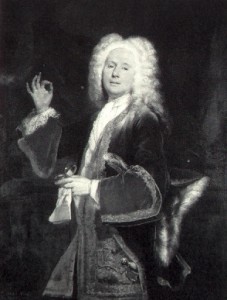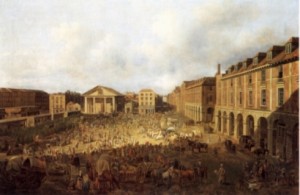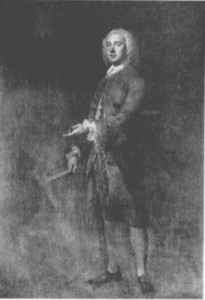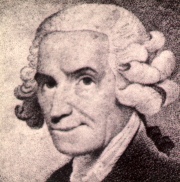William Boyce’s eight symphonies are not only the most well known and most recorded of all his works, but are also probably amongst the most famous, most played and most loved of any English Baroque musical work.
They were first published by John Walsh (Handel’s publisher) in 1760 but each one was in fact composed over the previous 21 years as either an ode to a vocal or stage work or as an overture.
At the time of publication Boyce was 49 and had begun to gradually withdraw from public musical life – probably because of his increasing deafness. These pieces were no doubt chosen for publication as a single set to represent his finest and most famous orchestral works.
Newspapers at this time show a strong growth in musical societies and public orchestral concerts and Boyce’s symphonies were presumably published to meet the correspondingly high demand for this type of work.
The title page (from the first publication in London in January 1760) reads:
EIGHT SYMPHONYS in eight parts
Six for Violins, Hoboys, or German Flutes, and Two for Violins, French Horns and
Trumpets, with a Bass for the VIOLONCELLO AND HARPSICHORD,COMPOS’D BY Dr. Wm. Boyce, OPERA SECONDA.
London. Printed for J. Walsh in Catherine Street in the Strand.
This description is not entirely accurate as bassoons and double basses (playing from the same part as the ‘cellos) are also needed as well as timpani in the fifth symphony.
The terms Overture and Symphony were synonymous at this time and were generally described as being either in the French or Italian style. The French style ‘overture’ began with a slow movement containing dotted rhythms leading to a fugue. Dance movements followed this. The Italian style ‘sinfonia’ or symphony was in three movements, slow-fast-slow. Boyce arranged his symphonies such that numbers 1-5 are in the Italian Style and 6-8 are in the French style. For the whole of his life Boyce continued to compose music in both styles in spite of the fact that the French style ‘overture’ was quickly going out of fashion.
When musical tastes changed in the latter half of the eighteenth century and audiences looked towards the new ‘classical’ style of Abel, J.C. Bach, Mozart and Haydn, the symphonies of Boyce were gradually dropped from the orchestral repertoire. The composer Constant Lambert (1905-1951) put them back on the musical map when he rediscovered them in the 1920s – leading to the first modern edition in 1928. Lambert made use of Boyce’s music in his own ballet ‘The Prospect Before Us’ which was produced by the Sadler’s Wells ballet company in 1940.
The symphonies are recognised today as being absolute gems of the period; bright, full of good tunes, well crafted and delightfully unassuming.
Symphony Number 1 in B Flat Major
Original title: Ode for the New Year (1756)
Three movements: Allegro, Moderato e dolce, Allegro
Instrumentation: 2 Oboes, 1st and 2nd Violins, Violas, Cellos, Double Basses and Bassoons.

Colley Cibber (1671-1757) actor, manager, playwright and Poet Laureate. Seen here acting the part of Lord Foppington in ‘The Relapse’
Background: Although Boyce was not officially made Master of the King’s Music until 1757 he took over the duties of the position immediately following the death of Maurice Greene in 1755. The first ‘royal’ work he composed was his Ode for His Majesty’s Birthday on 10th November 1755. This symphony was composed shortly afterwards and was first performed as the overture to the Ode for the New Year of 1756 ‘Hail, hail, auspicious day’ with words written by the poet laureate Colley Cibber (1671-1757).
Symphony Number 2 in A Major
Original title: Ode for the King’s Birthday (1756)
Three movements: Allegro assai, Vivace, Presto (Allegro)
Instrumentation: 2 Oboes, 1st and 2nd Violins, Violas, Cellos, Double Basses and Bassoons.
Background:This was originally the overture to the Ode for His Majesty’s Birthday on 10th November 1756 ‘When Caesar’s natal day’ with words, again, by the poet laureate Colley Cibber (1671-1757).
Symphony Number 3 in C Major
Original title: Overture to the Chaplet (pastoral opera 1749)
Three movements: Allegro, Vivace, Tempo di Minuetto
Instrumentation: 2 Oboes, 1st and 2nd Violins, Violas, Cellos, Double Basses and Bassoons.
Background: This was originally composed as the overture to ‘The Chaplet’ – a pastoral opera with words by Moses Mendez (1690-1758) which opened at the Drury Lane Theatre on 2nd December 1749. It was extremely successful, being given over 100 performances. John Walsh published the work in 1750. The title page stated:
The CHAPLET, A MUSICAL ENTERTAINMENT
As it is Perform’d at the Theatre Royal in Drury Lane.
Compos’d by Dr. Boyce.
London. Printed for I. Walsh in Catherine Street in the Strand.
Symphony Number 4 in F Major
Original title: Overture to the Shepherd’s Lottery (pastoral opera 1751)
Three movements: Allegro, Vivace ma non troppo, Gavot (Allegro)
Instrumentation: 2 Oboes, 2 Horns, 1st and 2nd Violins, Violas, Cellos, Double Basses and Bassoons.
Background: This was originally composed as the overture to ‘The Shepherd’s Lottery’ – a pastoral opera with words by Moses Mendez (1690-1758) which opened at the Drury Lane Theatre on 19th November 1751. Although following on from The Chaplet it was less successful. It was performed at the ‘Three Choirs’ festival in Hereford in 1753. It was published by John Walsh in 1750. The title page stated:
THE SHEPHERDS LOTTERY, A MUSICAL ENTERTAINMENT
As it is Perform’d at the Theatre Royal in Drury Lane.
Compos’d by Dr. Boyce.
London. Printed for I. Walsh in Catherine Street in the Strand.
Symphony Number 5 in D Major
Original title: Overture to St. Cecilia (1739)
Three movements: Allegro ma non troppo – Adagio ad lib – Allegro assai, Tempo di Gavotta, Tempo di Minuetto
Instrumentation: 2 Oboes, 2 Trumpets, Timpani, 1st and 2nd Violins, Violas, Cellos, Double Basses and Bassoons.
Background: This was originally composed as the overture to Part 1 of the St. Cecilia Ode ‘See fam’d Apollo and the Nine’ with words by Boyce’s friend John Lockman (1698-1771). The Ode was first performed at the Apollo Academy, London in 1739 and in the following year in Dublin, at the Great Musick Hall in Fishamble Street.
Symphony Number 6 in F Major
Original title: Overture to Solomon (serenata 1742)
Two movements: Largo – Allegro – Largo, Largetto
Instrumentation: 2 Oboes, 1st and 2nd Violins, Violas, Cellos, Double Basses and Bassoons.
Background: This was originally composed as the overture to ‘Solomon’ – words by Edward Moore (1712-1757). It was first performed at the Apollo Academy in the winter of 1742/3 and the first public performance took place on 22nd August 1743 at Ruckholt House in Essex. The overture and the complete Solomon serenata were first published by John Walsh in 1743. The title page stated:
Solomon, A SERENATA , In SCORE, Taken from the Canticles, Set to MUSIC, by
Mr. WILLIAM BOYCE, Composer to HIS MAJESTY, LONDON.
Printed and Sold for the Author, by J. Walsh in Catherine-Street in the Strand.
M.DCC.XL.III
Symphony Number 7 in B Flat Major
Original title: Overture to the Pythian Ode (1740/1)
Three movements: Andante – Spirituoso, Moderato, Jigg (allegro assai)
Instrumentation: 2 Oboes, 1st and 2nd Violins, Violas, Cellos, Double Basses and Bassoons.
Background: This was originally composed as the overture to the Pythian Ode “Gentle Lyre, begin the strain” with words by Walter Harte (1709-1774) based on the Greek poetry of Pindar. It was at one stage called ‘Pindar’s First Pythian Ode’.
Symphony Number 8 in D Minor
Original title: Worcester Overture (Date of origin unknown).
Three movements: Pomposo – Allegro, Largo (Andante), Tempo di Gavotta (Risoluto)
Instrumentation: 2 Oboes, 1st and 2nd Violins, Violas, Cellos, Double Basses and Bassoons.
Background:Of all the symphonies, only this one was originally composed as an orchestral piece, rather than as part of a vocal or stage work. According to the musical historian John Hawkins it was known as the Worcester Overture and was probably composed for a meeting of the Three Choirs Festival. Boyce directed the festival orchestra from 1737 and the Worcester Journal of 3rd July 1755 states that he, “continued to preside in that department for several years”. As the annual festival was (and still is) held at three different towns in rotation, the work could date from any three-year interval between 1737 and 1755. However, as Boyce made many revisions to the score it is presumed to have originated from an earlier rather than a later date.
Orchestra Size.
The number of musical parts printed for various early performances of the Symphonies give a good indication of the number of players in Boyce’s orchestra. The original parts of Symphonies 1 & 2 indicate that there were three desks (six players) of 1st Violins, three desks of 2nd Violins, one desk (two players) of Violas and four bass parts; one figured for use by the Harpsichord player, one for the ‘cellist, one for the Bassoon (probably two players) and one for a Double Bass player.
A Comparison of Recordings
I Solisti di Zagreb conducted by Antonio Janigro
Vanguard Classics 08 6115 71
The Academy of St. Martins-in-the-Fields directed by Neville Marriner (Recorded 1976)
DECC 444 523-2DM
The Academy of St. Martins-in-the-Fields directed by Neville Marriner (Recorded 1995)
CAPR 10 421
The English Concert conducted by Trevor Pinnock
Archiv 419 631-2
London Festival Orchestra conducted by Ross Pople
Arte Nova Classics 74321 340322
Bournemouth Sinfonietta conducted by Roland Thomas
CRD 3356
The Serenata of London directed by Barry Wilde
Carlton Classics 30367 01722
The Academy of Ancient Music directed by Christopher Hogwood
Decca Universal Classics 473 081-2
* * * * * * * *
The central movements of Symphonies 2, 3 and 4 are each marked with the Italian musical term ‘vivace’. Generally speaking this term indicates a very quick tempo, but in the eighteenth century it meant no more than lively – not necessarily fast. The composer and musician James Nares (1715-1785) left strong evidence to this effect in the preface to his book Twenty Anthems published in 1778.
He listed the common Italian musical terms in order of speed as: Largo, Larghetto, Andante, Vivace, Allegretto, Allegro. The fact that each of Boyce’s ‘vivace’ movements is sandwiched between what are definitely fast movements would also seem to emphasise the fact that a more sedate pace is required.
With this in mind I am afraid that I would not choose the recordings made by Barry Wilde, Antonio Janigro or Roland Thomas. They all take the ‘vivace’ movements very fast, especially Barry Wilde who, in Symphony number 2, chooses, what I feel, is a speed that makes little musical sense. In addition, Antonio Janigro is particularly ‘heavy’ (for example in the opening movement of Number 1) where a lightness of touch and a ‘bounce’ in the music is so important. With Roland Thomas, playing the ‘vivace’ movements too quickly leads him, presumably for contrast, to take some of the adjoining movements so fast that many of their subtleties are lost. It is a pity because in all other respects, including the sound quality, this is an excellent recording.
With reluctance I would also not favour the Ross Pople recording. Although I feel that tempos, phrasing and dynamics are all commendable, the disc appears to have been recorded with a small orchestra without bassoons, flutes, brass and percussion. Lacking the proper instrumentation indicated by Boyce, the sound is understandably thin and the set lacks the beautiful variety of sound that was obviously envisaged by the composer.
Also, symphony number 5 is not included on this recording – presumably because it simply could not be played without the necessary trumpets and timpani.
The excellent Trevor Pinnock recording is on authentic instruments and sounds very much how I imagine the symphonies would have sounded in the Eighteenth Century – a somewhat rustic feel to it – particularly in the Handelian opening movement of Symphony Number 5 with timpani and trumpets blazing. The music comes across as full of energy and sparkle.
The Christopher Hogwood recording is another excllent interpretation also on authentic instruments.
The Neville Marriner recordings, which have a much more ‘present-day’ delicate feel to them, are nevertheless excellent interpretations of this music. Of the two Neville Marriner versions I prefer the later one from 1995 which has an improved sound quality (not so much echo) and a better balance between instruments.
He brings the music to life – with the beauty of the ‘vivace’ movements brought out by slower speeds and the fast movements sounding bright and exhilarating. Strangely, the term ‘vivace’ is changed to ‘Andante’ in the CD notes.
In some slow movements (e.g. in numbers 2 & 3) he uses different instrumentation during repeated sections making the music more attractive and interesting to listen to.
The sound quality is excellent and even the notes accompanying the CD are very informative and well written.
On balance, I believe the Pinnock and Hogwood recordings, both on period instruments, and Neville Marriner’s 1995 recording on modern instruments, are equally very fine interpretations of these magnificient works.




Pingback: William Boyce, 1711 - 1779. English Baroque.
I need to to thank you for this excellent read!! I certainly enjoyed every
bit of it. I have you bookmarked to check out new things you post…
Many thanks for your comment. Good to know that you enjoyed the site.
great submit, very informative. I’m wondering why the other specialists of this sector don’t
understand this. You should continue your writing.
I am confident, you have a great readers’ base already!
Loved the info you provided on the Boyce symphonies.
Great site you have.
Many thanks for your comments.
Very informative and well-written commentary on these neglected Symohonies. You mention the “Handelian” opening to Symphony No. 5 and the similarity to Handel’s “Wassermusik” is obvious. Do you happen to know who copied who? My guess is it was probably Handel as although he died 20 years before Boyce in 1759, the Symphony dates from 20 years earlier in 1739.
Many thanks for your kind comments. As you say there are similarities in the music of Handel and Boyce and ‘copying’ from other composers’ works seemed to be very prevalent at the time. However, I am not aware of any Boyce pieces that bear such a close resemblance to any of Handel’s that copying is suspected by either party. I would have thought it was more a case of influence and inspiration than of actual copying.
Many thanks for the excellent short article, I was hunting for specifics similar to this, visiting visit the other blog posts.
Firstly, I want to commend you for your insightful and well planned reviews of Boyce’s Symphonies. I wonder why, though, you did not review the Yehudi Menuhin recordings.
Secondly, do you submit reviews of other composers, perhaps from the Classical and/or Romantic period(s)?
Thank you, once again, for furnishing this web site.
Many thanks for your kind comments.
I did not intentionally miss out the Menuhin recordings; I simply did not know at the time that they existed. However, I have now listened to a couple of the symphonies and unfortunately he does take some of the Vivace movements very fast! Although, apart from that, I did like a lot of what I heard.
I have never reviewed other composers’ works. It is just something that I thought was needed for the site regarding the many recordings of Boyce’s symphonies.
Thank you again.
Thank you for your analysis which adds to my musical culture. Am interested in Boyce’s fugal style. Somehow he keeps the melody interesting and present throughout.
Thank you for posting your thoughts on Boyce. I have always thought that his fugues seem different to those of other composers and, as you say, they are so very interesting.
Thank you for filling one particular gap in my musical knowledge; I Googled William Boyce after listening to his Fourth Symphony on Classic FM. I was familar with the music but hadn’t even heard of the composer. Your exposition was most interesting and informative. We live and learn!
Many thanks for your kind comments. It’s good to know that Classic FM are broadcasting Boyce’s music. Thanks again.
This was a thorough, informative and fascinating read. I have enjoyed the 8 Symphonies for years and I particularly favor the Hogwood interpretation over the Pinnock. I had no idea that these Symphonies had been composed over many years for varying occasions. Thanks again for such excellent scholarship.
Many thanks indeed for your kind words. So glad you found this so interesting.
Many many thanks for taking the time to research and write this. I’ve had the Hogwood and Pinnock recordings since they were originally released and listen to them regularly. Your article puts Boyce securely in his context and genuinely gives insight into his music. Be blessed.
Many thanks indeed for your very kind comments.
Agradezco toda esta info ya que no recuerdo haber oído
obras sobre este compositor.
Ayer domingo 12 de noviembre 2017 escuché la 5a.sinfonía
y vine a aprender sobre este compositor.
Muchas gracias
Thank you very much for your comment.
I have the hogwood version and it’s marvellous a wonderful interpretation of these Devine pieces.
Boyce – and the other ‘Handelians’ are particular favorites of mine. They reflect the surge of music-making in 18th-Century London – a wonderful, busy time for musicians and audiences. Both period performances – English Concert and the AAM – are superb, and there are also recordings of trio sonatas that should not be overlooked.
Thanks so much for your comment.
Having grown up with a love of pop & rock music and latterly ‘dance music’, I have also delved, in recent years, into classical music… and the Baroque period has turned out to be my favourite. I find the period fascinating with the advent of new ideas and the ‘Age of Enlightenment’. The music reflects those hopes and aspirations and, so far, William Boyce’s Eight Symphonies (Pinnock) is top of my list . The music conveys energy and joyfulness with cascades of melody and counter-melodies.
Your website is great and full of interesting information about this important period.
Thanks very much indeed for your comments.
I totally agree with you regarding William Boyce; such wonderful music.
I too started with popular music and was drawn towards baroque.
Dear Sir,
I have been looking for this kind of discussion of Boyce’s music; thank you for writing it. Do you know which Boyce compositions were used by Constant Lambert in ‘The Prospect Before Us?’
Thank you.
The music is from Boyce’s symphonies.
Bridgwater Choral Society in Somerset are performing both orchestral and choral works of the 18th Century and are including the 4th & 5th Symphonies by William Boyce on Saturday 30th November 2019. Venue: St. Mary’s Church in the centre of Bridgwater, just 15mins off Junction 23 of the M5.
This website has been extremely useful for me to write my Press Releases.
Thank you.
CBJ Choir Publicity Officer
Good to hear of the performance of these wonderful works. I hope it all goes well. Glad the website was useful to you.